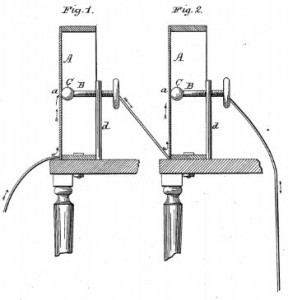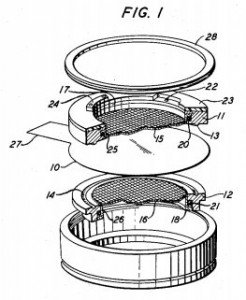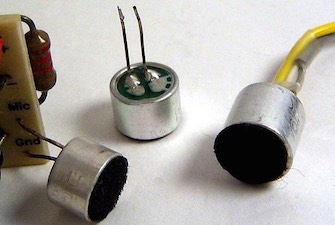Microphones can be found just about everywhere nowadays. Most people reading this article will have a cell phone in their pocket which uses a microphone to transmit an audio signal to other phones all over the world. Many laptops and computers now come with microphones as a standard feature instead of offering those products as peripheral side equipment that must be purchased separately. Outside of consumer gadgetry, microphones can also be crucial for business telecommunications, the entertainment industry, aerospace applications, medical devices and more.
Of all of the types of microphones in use today, the electret microphone is the most commonly used version; 90 percent of all microphones used today are of the electret variety, resulting in almost two billion electret microphones being manufactured every year. Invented during the 1960s by a team of researchers working at Bell Laboratories, the electret microphone possessed superior characteristics, like improved sensitivity and greater cost-effectiveness, over the commonly used carbon microphones of that time. The discovery of the electret microphone enabled some great advances in many of the technologies mentioned above which rely on microphones that are small in size and can create clear audio signals.
We’re returning to our Evolution of Technology series to take a look at the history of this particular area of sound technology development. The microphone has gone through many iterations since the 1870s when audio transmission technological innovations were at their most nascent stage. Although the microphone may not be the cultural icon that it was back in the days of the radio shows that dominated entertainment through the first half of the 20th century, it is nevertheless a ubiquitous product which continues to find useful applications in our world.
[Varsity-2]
The Early Days of Microphone Technology
 The late 1870s is when microphone innovation starts to take off. German-born American inventor Emile Berliner was one early names in microphone development and in 1877 he invented the carbon-button microphone, a drum-like product capable of converting sound into voltage and even amplifying that voltage when it left the microphone. We were able to track down a patent related to Berliner’s work, U.S. Patent No. 463569, entitled Combined Telegraph and Telephone. It claimed a method of producing electrical undulations similar to soundwaves within a circuit by causing soundwaves to vary the pressure between electrodes which are in constant contact, substantially increasing and diminishing the circuit’s resistance. This patent was issued to Berliner in November of 1891.
The late 1870s is when microphone innovation starts to take off. German-born American inventor Emile Berliner was one early names in microphone development and in 1877 he invented the carbon-button microphone, a drum-like product capable of converting sound into voltage and even amplifying that voltage when it left the microphone. We were able to track down a patent related to Berliner’s work, U.S. Patent No. 463569, entitled Combined Telegraph and Telephone. It claimed a method of producing electrical undulations similar to soundwaves within a circuit by causing soundwaves to vary the pressure between electrodes which are in constant contact, substantially increasing and diminishing the circuit’s resistance. This patent was issued to Berliner in November of 1891.
Berliner was able to sell the rights to his innovation to Alexander Graham Bell for $50,000, an amount that comes closer to $1.1 million in today’s dollars. Although this helped to establish Bell’s telephone as a widely sought-after product, a 1892 U.S. Supreme Court ruling gave credit to Thomas Edison for creating the microphone. It’s very likely that neither truly deserved the patent rights, however, as it has been noted that the concept of the carbon-button mic had been proposed years before either of these inventors filed for a patent.
Over the course of the next century, carbon microphones were essentially the standard technology for converting sound into an audio signal, although some notable improvements were achieved along the way. An article from the April 1924 issue of Popular Mechanics discusses advances made by Dr. Phillips Thomas, an employee of Westinghouse Electric and Manufacturing Company. His “ultra-audible microphone” was capable of picking up a much wider range of soundwave vibration, supporting more perfect sound reproduction for radio technologies. Phillips Thomas was listed as the sole inventor on U.S. Patent No. 1682443, titled Resistance Microphone and Method of Operating the Same. It claimed an electrical system containing a resistance microphone, a resistor, a means for providing energizing currents to the microphone and a condenser connected to a lead having a negligibly low reactance to low frequency currents. This patent issued in August 1928. The invention was developed to address sound distortion issues created by a microphone’s transformer when different sound frequencies created different impedances in the transformer.
The early half of the 20th century could be seen as a golden era of sorts for the microphone. The creation of the Federal Radio Commission in 1927 presaged the development of the radio as a major form of consumer media over the next few decades. Sports broadcasts, news bulletins, comedies and dramatic radio plays would connect with millions of Americans thanks to the advances in microphone technology that had been made.
The ribbon microphone was another major step forward in pioneering the modern microphone technology we’re familiar with today. Ribbon microphones were widely commercialized by the Radio Corporation of America (RCA) and worked by capturing sound bidirectionally and using a thin electrically conductive ribbon to convert the sound into an audio signal. We were able to find a ribbon microphone patent assigned to RCA: U.S. Patent No. 1892645, issued under the title Sound Pick-Up Device. It disclosed a microphone having a single means, one portion of which is responsive to the pressure gradient of a soundwave and another portion of which being responsive to the soundwave’s pressure. By responding to both the pressure and the pressure gradient of a soundwave, this innovation was capable of producing a ribbon microphone that collects sound from a predetermined range and excludes sound from beyond the range.
James West, Gerhard Sessler and the Electret Microphone
Obviously, the miniscule microphones found in our smartphones and other electronic devices are a far cry from the bulkier units used for radio broadcasts. To get there, we needed a pair of researchers at Bell Laboratories who pioneered the discovery of electrets and their use in microphones. An electret is a piece of dielectric material, which has electrically insulating properties, which has been heated and cooled in a certain way so as to produce a material with an overall fixed dipolarity, creating a fixed static potential between the opposite charges.
James West, one of the inventors of the foil electret microphone, had been interested in how electricity worked from a very young age. In the early 1940s, when West was around the age of 10, he received an electrical shock from a ceiling outlet while standing on a brass bed at his childhood home in Prince Edward County, VA. Uninjured by the incident, West’s curiosity was piqued by electricity and how it worked, launching him towards a path of studies leading to a degree in solid state physics from Temple University. In the mid-1950s, West was hired as an intern at Bell Laboratories.
Joining West in the electrical engineering work at Bell Labs leading towards the creation of the electret microphone was Gerhard Sessler. Born in Rosenfeld, Germany, Sessler would return to Germany after his work with Bell Labs ended in 1975, where he would continue to innovate in the area of silicon micromachining for microphones.
In the early 1960s, both West and Sessler were assigned to work on an acoustical science project at Bell. In order to research the subtleties of human hearing, a group of acoustical psychologists required more sensitive microphone equipment. The two were able to get close to what the psychologists needed through the use of a solid dielectric condenser microphone powered by a 500-volt battery. To lengthen the service life of the microphone, the battery’s polarity needed to be reversed at various times. Once when West and Sessler were reversing the battery’s polarity, the leads shorted out and the microphone produced an incredibly loud signal, even after the battery power source was removed.
The continuous charge produced by the microphone was made possible when the shorted battery caused a conversion of the dielectric material to an electret material. The strong electric field applied to the dielectric causes a reaction that allows the electret material to retain its electric polarization.
 Both James West and Gerhard Sessler are members of the 1999 inductee class to the National Inventors Hall of Fame. Both have been named on many patents but the main one highlighted by their hall of fame induction is U.S. Patent No. 3118022, which is titled Electroacoustic Transducer. Issued on January 14th, 1964, this patent claimed an electroacoustic transducer having conductive electrode members on two different planes, a means for supporting those members in juxtaposition to each other, a prepolarized diaphragm composed of thin film electret and conductive materials, a means for tautly supporting the diaphragm between the two conductive electrode members and a means for electrically connecting the conductive members. By taking advantage of the dielectric properties of plastic films, this invention was capable of achieving microphone operation without the need for frequent recharging. It also allowed for better intimate contact with the human body, making it optimal for hearing aids or other such devices.
Both James West and Gerhard Sessler are members of the 1999 inductee class to the National Inventors Hall of Fame. Both have been named on many patents but the main one highlighted by their hall of fame induction is U.S. Patent No. 3118022, which is titled Electroacoustic Transducer. Issued on January 14th, 1964, this patent claimed an electroacoustic transducer having conductive electrode members on two different planes, a means for supporting those members in juxtaposition to each other, a prepolarized diaphragm composed of thin film electret and conductive materials, a means for tautly supporting the diaphragm between the two conductive electrode members and a means for electrically connecting the conductive members. By taking advantage of the dielectric properties of plastic films, this invention was capable of achieving microphone operation without the need for frequent recharging. It also allowed for better intimate contact with the human body, making it optimal for hearing aids or other such devices.
A good rule of thumb for gauging the historical impact for any invention is to take a look back after a few decades and see how many of those products are still being used. If necessity is the mother of invention, ubiquity is proof of success in innovation. The manufacturing numbers cited in the first paragraph of this article are pretty good proof that electret microphones are still making their presence felt more than fifty years after they were conceived. A world without electret microphones would be a world without cell phones and more cumbersome hearing aids, and it would be a much more difficult world to live in for many people.

![[IPWatchdog Logo]](https://ipwatchdog.com/wp-content/themes/IPWatchdog%20-%202023/assets/images/temp/logo-small@2x.png)



![[Advertisement]](https://ipwatchdog.com/wp-content/uploads/2024/04/Patent-Litigation-Masters-2024-sidebar-early-bird-ends-Apr-21-last-chance-700x500-1.jpg)

![[Advertisement]](https://ipwatchdog.com/wp-content/uploads/2021/12/WEBINAR-336-x-280-px.png)
![[Advertisement]](https://ipwatchdog.com/wp-content/uploads/2021/12/2021-Patent-Practice-on-Demand-recorded-Feb-2021-336-x-280.jpg)
![[Advertisement]](https://ipwatchdog.com/wp-content/uploads/2021/12/Ad-4-The-Invent-Patent-System™.png)







Join the Discussion
4 comments so far.
Michael
July 8, 2015 08:21 pmMEMS microphone annual shipments now constitute over 50% of the market (>1billion). They are still more expensive than electrets but far superior in performance, stability and phase matching. The low cost segment is still occupied by electrets, and is hard to displace (low margins).
Benny
July 8, 2015 11:38 amAccording to an industry teardown, the iPhone 5 uses MEMS microphones (3!). Most other current smartphones use them too. (cost about $0.6) They are definitely the component of choice for the consumer industry, but the professional recording and broadcast industry has always been more conservative. The dynamic microphone was used in recording studios for years after the electret type took over the consumer market.
Gene Quinn
July 8, 2015 11:25 amBenny-
I don’t know how rapidly the displacement is happening. Well over 90% of all microphones today are electret microphones. The invention was revolutionary, which isn’t to say that someday it too will become obsolete.
In any event, I’ve met James West a couple of times and have seen him speak at the USPTO. He explained that his invention reduced the cost of a high quality microphone dramatically. Prior to his invention a high quality microphone would cost thousands of dollars. The components of an electret microphone would cost less than $1, which made it possible for microphones to become affordable by anyone who needed one.
-Gene
Benny
July 8, 2015 05:08 amElectret microphones are rapidly being displaced by MEMS microphones (Micro Electro-mechanical system) which have the advantage of smaller size and lower power requirements.